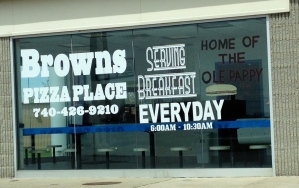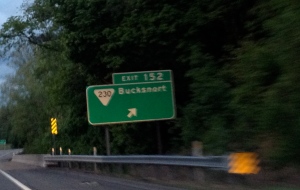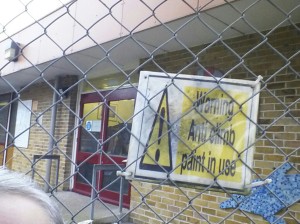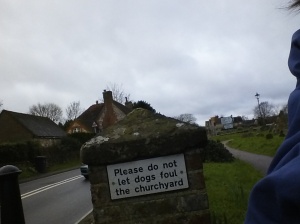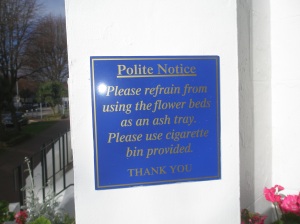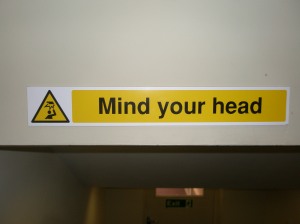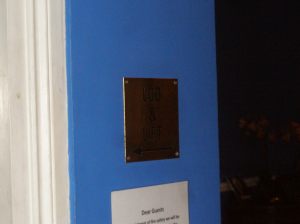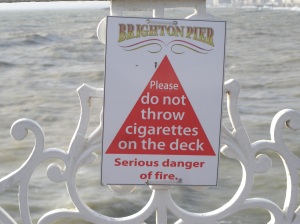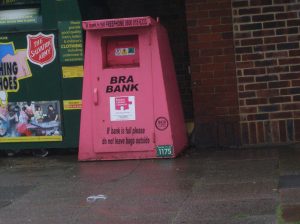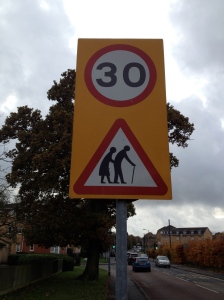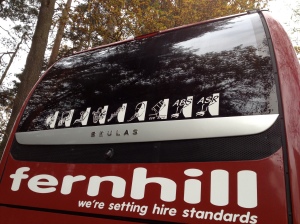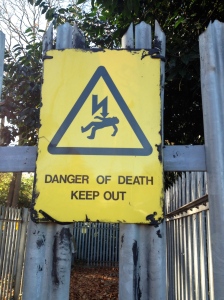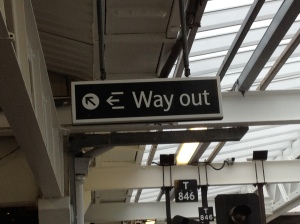Who Are You?
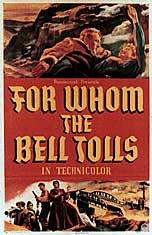 Being a professional editor and former lexicographer, I waffle between strict grammarian and bemused usage observer, so even I have to take some of my grammar rants with a grain of salt. I mean, pop culture has so many examples of bad grammar but good choices. The “who-whom” dilemma is a good one to illustrate this phenomenon. For instance, would anyone have remembered or sung along to the theme for The Ghostbusters if the chorus had been “Whom you gonna call?” And you know just what Little Milton is singing about without insisting he change to “Who’s Cheatin’ Whom?” And, although I wouldn’t consider The Who the most grammatically correct rock group in the world, at least their eponymous song uses this prounoun correctly.
Being a professional editor and former lexicographer, I waffle between strict grammarian and bemused usage observer, so even I have to take some of my grammar rants with a grain of salt. I mean, pop culture has so many examples of bad grammar but good choices. The “who-whom” dilemma is a good one to illustrate this phenomenon. For instance, would anyone have remembered or sung along to the theme for The Ghostbusters if the chorus had been “Whom you gonna call?” And you know just what Little Milton is singing about without insisting he change to “Who’s Cheatin’ Whom?” And, although I wouldn’t consider The Who the most grammatically correct rock group in the world, at least their eponymous song uses this prounoun correctly.
Who vs. Whom
Nevertheless, when you’re writing a paper or a book and need tidier grammar, you need to know the difference between “who” and “whom,” when to use which one. The easiest way to figure it out is to substitute another pronoun for “who” in your sentence and use the same form. So, for example, in the sentence below, substitute “she” for “who” and you can see that “who” is the wrong choice here.
The house is on fire and I don’t know who to call!
The correct usage in this sentence should be “The house is on fire and I don’t know whom to call!” The more formal way to explain the difference is this: Use “who” for nominative case uses (i.e., subjects of sentences and clauses); use “whom” for objective case uses (i.e., direct and indirect objects, objects of prepositions).
For further explanation, Louise at Glossophilia writes an excellent piece about “whomever” and how to use it (which actually parallels what I’ve already said: who = nominative case, whom = objective case).
The Demise of Whom?
All of that said, I happened upon an article in The Atlantic from earlier this year, which has some surprising ideas about the demise of “whom”—surprising in that the lexicographer in me tends to agree with the arguments for eliminating it. Those arguments—it’s on a steep decline anyway, its use is confusing and can be tough to explain, our culture’s increasing informality identifies anyone who uses “whom” as pedantic nerds—don’t hold water for editors.
But as a very wise editor I once knew always said (in line with William Safire, quoted in The Atlantic article), “When in doubt, leave it out.” (She’d be angry if she knew I used her rule of thumb to cheer the dismissal of “whom,” but comparing her to William Safire, a Nixon speechwriter, will make her stomping mad!)
Given the rampant misuse of “whom” and the disparaging regard most of the public has for proper grammar, perhaps eliminating “whom” altogether is a better solution than struggling against the overwhelming force of improper usage.
Memphis Road Trip Signs 2013
Earlier this month we traveled to the Beale Street Festival in Memphis. We decided to make it a road trip, air travel being too expensive and really irritating nowadays, and we found more fun signs along the way.
Our route took us through southwestern New York, where there’s a large Seneca Nation reservation, and the highway signs include the Seneca language. Oddly enough, the casino signs for said reservation aren’t in that language.
Traveling through the South, you kind of expect to see billboards exclaiming about doom and gloom and professing to have the answer for your salvation. So I wasn’t surprised by this one, which is actually quite tame, comparatively.
If you look carefully, you’ll see a surprising (in this day and age) Southern phrase in the right-hand corner. Actually, as someone who spent her first eight years as a Southerner, I never thought it meant anything than an old man and/or grandfather. But what do I know?
Yep, they still say “y’all” in the South. And not just on water towers.
It’s hard to take a road trip in this country without seeing a sign for a really oddly named town or city. This one is my favorite from Tennessee, taken on I-40 between Memphis and Nashville.
Rescuing the Semicolon from Punctuation Pirates
You know it; I know it: we live in an age of reckless punctuation usage, where perfectly good punctuation is abandoned or abused, ignored or perverted. The greatest victim of this abuse is probably the semicolon, that once-great denizen of the compound sentence. Being a writer and editor of a certain age, I’ve been around long enough to see error evolve into ignorance and acceptance. Now, in this wild age of anything goes—in texting, IMing, e-mailing, print on demand, and all other forms of quick communication—I’m beginning to think that what was once wrong is becoming the new norm and rule.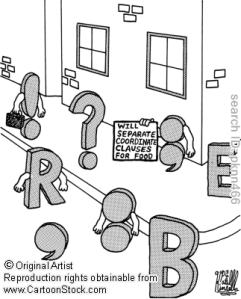
How to Use the Semicolon
Semicolons should be used in three situations:
- To separate long phrases or clauses in a series, primarily because the phrases have their own internal punctuation
- To divide two independent clauses in the same sentence, usually because they’re related and you want to indicate a stronger relationship between them than a period (i.e., two sentences) would
- To separate two clauses joined by an adverb such as “however” or “that is”
Lots of grammar books and online sites can explain the proper use of semicolons, and some may actually provide more examples of proper usage. (It’s really the same three rules, when you get right down to it.) I suggest The Chicago Manual of Style, Merriam-Webster’s Dictionary, Grammarly.com, or a fun site called The Oatmeal.
If I read some book or article that errs by using the semicolon instead of the comma, I usually assume the publication didn’t bother to hire a copyeditor or proofreader, either of whom should know better. The University of New Mexico Press, for instance, really ought to have spent a few hundred dollars on a copyeditor for Hollywood Shack Job, a truly poorly written book by Harvey Kubernik that could have been much better. In the sentence below (found on p. 157 of said book), you not only get an idea of how to screw up a sentence by misusing a semicolon, you also learn how an interesting topic can be rendered deadly boring by a guy who couldn’t finesse the written interview if his life depended on it:
And then there’s our countrymen from Canada; Joni and Neil Young—and the whole thing just snowballed in a way and it was almost like your job, a good portion of the time, was to get out of the way.
The same kind of error surprises me occasionally in more respectable publications, like the essay in the New York Times Book Review from a few weeks back. Jay Ruttenberg discussed “the fallen rock star [who] gets an encore in contemporary fiction,” yet he seems to have fallen asleep back in grammar class. “I was a recovering rock critic; a music nerd at rest.” The second clause in that sentence is far from independent, so the punctuation should be a comma. Tsk tsk.
Will Error Become Accepted Usage?
The primary abuse involving the semicolon that I see is when a writer inserts a comma—that Jack of All Trades for the conversational pause—between two independent clauses. Here’s the thing: commas need conjunctions (and, but, or, and the like) to separate clauses; they work with conjunctions—as partners—to introduce new clauses. Semicolons act as dividing lines between independent clauses, but they do it alone, without needing conjunctions as partners.
At first this misuse of a comma appeared mostly in ignorant high-schoolers’ essays and in remedial freshmen college compositions. Teachers and professors would dutifully correct the errors and mark them down a grade. Then that comma-as-semicolon started appearing in business letters and memos, third-rate publications and hometown newspapers, suggesting those college students never should have passed remedial composition. And in the communications workplace, I began having arguments with fellow editors who thought the comma-as-semicolon was fine “in informal usage” or “in dialogue” or somesuch nonsense.
Now I’m seeing them in all sorts of middle- and high-brow writing, the pinnacle (for me) of which is the rampant misuse in Hilary Mantel’s Booker Prize–winning novel, Bring Up the Bodies. As much as I admire Mantel’s writing and enjoyed her two historical novels about Thomas Cromwell (the first of the two is Wolf Hall, which also won her the Booker Prize), I found myself quite vexed by the comma-as-semicolon throughout the book. About halfway through the book, I began jotting down the instances I found (no doubt reading over some, as the book really is quite good), and I listed at least 30 cases. Here are a couple examples:
He said, she can be laid to rest in Peterborough, Peterborough is an ancient and honourable place and it will cost less.
You must give it at Lambeth, Norfolk will not come to me, he will think I plan to put a sleeping draught in the claret and convey him on board ship to be sold into slavery.
Look at you, all fleshed out in your gown, an ogre would eat you roasted.
In each of these instances the commas should be changed to semicolons. I cannot believe any author could seriously convince me of some exception to the rule of using the semicolon between two independent clauses. Yet as I read Mantel’s book, focused as I was on the semicolons and commas, I discovered several instances where the comma-as-semicolon seemed to stand in for the missing conjunction. Other situations in grammar allow punctuation to be substituted for words or letters that are understood as part of the sentence or structure. Apostrophes replace missing letters in contractions (don’t, isn’t, doesn’t), and declarative sentences regularly omit the subject “You” (“Leave me alone!” instead of “You leave me alone!”). Is it possible that a new usage, one developed from the expediency of our hurried, modern communication, has found a way to change the rules for semicolons and commas?
Here are more examples of the comma-as-semicolon from Mantel’s book, but note how the conjunction (coordinating or subordinating) is understood in each:
And some things he doesn’t need to be told, he can see and hear for himself. (“because” is understood; p. 221)
Come, uncle, take a crumb from my hand, you are wasting away. (“for” is understood; p. 190)
We find him pacing, hungry for conflict, we ask ourselves, does he know why he is here? (“and” is understood; p. 333)
And then there’s this example from the London Review of Books, a quote from Building Stories by Chris Ware that the reviewer mentions (for different reasons):
I’d already acceded [sic] so much to Phil, it was all I had left. (“that” is understood)
I’ve begun seeing more and more of the comma to divide two independent clauses, and now I shall record how many are possible stand-ins for the understood conjunction. As a writer, editor, lexicographer, and grammarian, I could be convinced of this new usage. Maybe. Could you?
In Which I Take Rolling Stone to Task on Several Counts
I’ve been reading Rolling Stone magazine for years, and, although the magazine is rather irreverent (my favorite special feature is “Ask Dr. Ozzy”) and it doesn’t hesitate to print obscenities (not surprisingly found in great abundance in said special feature), I do expect a high level of editorial excellence. I mean, the magazine wins awards for its writing all the time (or so it tells me).
The Homophone Mistake
Imagine my astonishment, then, when I encountered a particularly egregious homophone error when reading the cover story from the November 22, 2012, issue earlier this week (I’m behind on my reading; so sue me). A short article on Daniel Craig (his new Bond movie had just come out), this story described Craig’s dress during an interview with the writer.
He smooths down his white T-shirt. There’s something about that white T-shirt on Craig. It’s irritating. It’s so perfect on him, the way it hugs the aeronautic V of his torso, the neckline so crisp against his tan skin, the armholes stretched taught by his muscles, but only in the most pleasing way, not an ostentatious display at all [my emphasis].
Whoa! Does no one at Rolling Stone realize that “taught” is the past tense of “teach,” and it’s homophone, “taut,” means having no slack or give, unflabby, in good shape? I don’t think I’ve seen such an elementary homophone mistake as that since grade school. And this is a national magazine with millions of readers?! Surely someone on staff—someone tasked with proofreading every word of every version before the pages are sent to the printer—would have seen “taught” in that sentence and known to change it to “taut.”
To Make Matters Worse . . .
In preparing to write about this unfortunate misstep, I thought I’d check to see if the mistake had been corrected online. So I set my browser for rollingstone.com, and discovered that I couldn’t look at the Daniel Craig article without setting up an account and/or being a subscriber. Okay, so I’m a subscriber, I thought; I’ll just log in that way.
Here’s where I encountered more insult from Rolling Stone. The visual for finding and inserting your subscriber account number in the online form is miniscule and very hard to read. It took me about seven tries to get it right. Grrrr. Once I finally did, I encountered a notice to download Silverlight before proceeding to the archives. Apparently it will help me access them. It’s hard to know, because RS didn’t bother to explain on that page what Silverlight is for. Nor did they send me to Silverlight’s site to download the application—a standard online courtesy to ensure you’re getting what the middleman (RS in this case) says you’re getting.
The topper was when, after downloading and installing Silverlight, I reloaded the blocked page—as per RS’s instructions—and still couldn’t access the archives. So I’m a paying subscriber, I’ve set up an online account, I’ve downloaded and installed the application they say I need to access the site, but they won’t let me. If there’s one thing I hate as much as poor grammar, editing, and proofreading, it’s poor usability. Rolling Stone, in one fell swoop, stuffed all four down my throat today. It’s enough to make a girl cancel her subscription.
Do you think the New York Times would hire Dr. Ozzy?
English Road Signs Addendum
Just a couple months after we traveled to England, Mike’s brother and sister-in-law took their own trip there, mostly to do some ancestry detective work and meet long-lost cousins. They sent a couple more signs to me that I thought I’d share with you.
It may be a bit hard to read through the fence, but I would love to hear someone explain what “anticlimb paint” is. Apparently this was posted by a children’s playground. Seriously?
There are just so many ways to interpret this one, but I’m sure the obvious one is the intended request here.
May 1: More Signs!
It took a while, but I finally found time to post more English road signs, these from Mike’s brother and sister-in-law. They found a real treasure trove, don’t you think?
England’s version of the Dollar Store: Everything’s a pound! Wonder if the quality of the merchandise is as high.
The bevel of these steps seems pretty obvious, but just in case it wasn’t, the British want you to know!
I don’t know about you, but I’ve definitely got radar for toilets, especially public toilets. But wait! They’ve figured out how to lock my radar?! Crimmeny!
So my dictionary says a tout is a spy. Apparently the British have a domestic surveillance problem of its own.
Hm. So I get the “bin” part here. But what are we stubbing and what exactly does that mean? Oh! I get it: It must refer to those little white sticks that the crowd around a doorway like to stick in their mouths. (Sometimes it takes a while to comprehend English road signs.)
I love this one for the tone. I mean, if you ask nicely, you’re more likely to get people to behave the way you want, aren’t you? It’d be fun to compare the area around this sign with the area around the previous sign to see which is more effective.
I don’t know where this sign was located, but it doesn’t look like it’s by the airport. So what does it mean? I really have no idea.
I like this one because everyone expects to see “Mind the gap” signs, so this one has a twist. Besides, the little diagram makes me chuckle.
Doesn’t everyone feel lifted by a visit to the loo?
So I can guess what a horsebox is, but wouldn’t a sign that warns about low clearance matter as much for a horsebox as anything else? And how exactly does “for access” restrict anyone in any vehicle?
I tried to understand the significance of the red cross on the “T” here but got distracted by the cute meerkats. Seriously, who would care about the road sign when you can gaze at those guys?
At first I noticed that British Gas uses VWs as their vehicle of choice, which works for me, the proud owner of a 2007 Rabbit. But then I read the message on the back window and wonder just how good their workmanship could be if any customer needs “ongoing care.”
This sign is the counterpart of the “stub it” and “polite notice” ones above: It tells you unequivocably—it doesn’t even bother to ask you—where the cigarette butts belong. And in case you’re in the running for a Darwin Award, it lets you know why they don’t belong on the pier. In the word of Homer Simpson, “Doh!”
I’m sure there’s a risque joke in here somewhere, what with staying off groynes and all.
This one has lots going for it: it’s pink, for one. And they’re making no excuses: they’re asking for your old bras! Don’t we American women just hide the old ones in a bag full of sweaters that we drop off at the Salvation Army? Then there’s the line at the bottom, which sounds like something a 15-year-old boy would guffaw over for at least 10 minutes.
Here’s one spotted in the U.S.A., but it’s a good one.
Thanks to Joe and Luanne for the signs and sharing them!
English Road Signs
Recently we returned from a visit to England, where I was much amused by that country’s use of language on road signs and a few other items. I’ve learned to appreciate many parts of English life: roundabouts are brilliant, pedestrians are the rule rather than the exception, and the English seem so much more friendly and human than the “stiff upper lip” stereotype would lead you to expect.
See what you think about this amusing collection of signs.
This one is probably my favorite, even without the grinning guy. The sign is the British equivalent to, say, “speed bumps ahead.” But that’s not as much fun as “humps for 200 yards.”
Please note the really tasty advertisement for the traditional fish and chips dinner: “mushy peas.” Wouldn’t you like to try some?
For those of us getting on in years, it’s nice to know we’ve got our own warning signs.
If you look closely, you’ll note the hilarious pun on the back of this bus. Our daughter, the pun connoisseur, would be so pleased.
Something about this poor little guy getting zapped by a giant backward “N” just can’t be denied.
We were quite puzzled to see these signs, which advertised potential zebra sightings (and crossings) yet illustrated pretty odd-looking zebras. In fact, the crossings themselves, painted onto the roads, are in black and white zigzags, so they evoke a zebra look but are really warnings for pedestrian traffic.
You may hear a lot about “mind the gap” signs, but honestly this is the only one I saw. And we traveled a good bit on trains and the Tube. Go figure.
How delightfully exact and simple are these signs? Who needs to learn what “exit” means when you’ve got this much more helpful phrase?
This sign, tacked high above a light pole beside the train station, confused the bejeebers out of me at first. My grammarian self couldn’t understand what was “except for taxis and passenger set down.” And “set down”? Wha? I finally realized that the area underneath the sign was restricted from any parking except for taxis and others who are dropping off train passengers. Whew!
Apparently the British have found a new usage of “clamped” as a transitive verb that means to be set upon and rendered immovable (as a car) by big metal clamps. Imagine that!
Mixing up Words
God bless the Interwebs! Without it, our children (and even the younger of us adults) would probably know how to spell simple words, understand homonyms, find typos in our messages. But then the rest of us wouldn’t be able to find and enjoy mix-ups such as these:
“Bruce was left singing and playing his guitar in vein.”
From a blog post on the London Evening Standard’s website, in which he provides his “I was there” commentary on the story about the concert in which Bruce Springsteen’s and Paul McCartney’s microphones were cut off to follow the noise curfew in the area.
I wonder if the blogger knows what a homonym is. I’d settle for him knowing that “vein” is what your blood flows through and doesn’t mean the same thing as “in vain.”
“I’m getting my associate’s degree and progress tord graduation.”
From a personal e-mail from the manager of a credit union, sent to someone I know .
It seems that people don’t bother to proofread their e-mails anymore. Or maybe she did. Yikes!
“Michaela was great and did exactly what I asked for. Will defiantly return!”
From an e-mail sent by a local salon which included client testimonials about their experience. I love this one for its inadvertent insouciance. I expect it was originally made by the customer and not the salon.
No doubt you all could share more of these fun goofs. Got one for me?
Signs, Signs, Everywhere Are Signs
I just returned from a fun road trip, during which I collected pictures and took note of signs that tickled my fancy. They were funny on purpose or inadvertently funny, oddly matched or just odd, clever or silly, on billboards or on vehicles. And of course there were the occasionally grammatically misguided ones.
Some of the ones that went by too fast for photos:
- Savage Taxidermy
- His and Hers Seafood
- South of the Border: You never sausage a place! You’re always a wiener at Pedro’s!
- Open-minded billboard seeks long-term relationship (with a picture of a bikini-clad blonde beside a pool)
- Worms are here (at rural NY gas station)
Others announced themselves in time for my camera. See for yourself!
Road Trip 2012 Signs Slideshow
(goes to Flickr slideshow; click on “show info” to read the captions)
Grammar Tip #2: To Cap or Not to Cap
As a lifelong editor, I’ve encountered quite a few grammatical errors, and I’ve even made a few of my own. (First rule of editing: You can never ever be perfect all the time.*) Author errors can be funny, off-handed, stupid, careless, obtuse, and common. In the latter category, I’m constantly amazed at how frequently people want to use capital letters on words that shouldn’t have them. Although not often an issue in the books I’ve edited for academic presses, this common writing error abounds in—surprise!—more common writing.
Capping nouns is a Teutonic thing, I guess, since all nouns in German get capitalized. Must be the German immigrant influence that makes aspiring writers want to see the big letters scattered throughout their copy. Or maybe they think the capital letter means it’s a more important word, gives it more emphasis. They probably text each other with caps lock on, too.
Capping on Campus
When I worked in the communications office of a local college, we regularly had to lowercase nouns in the copy that came to us. It seems everyone wanted their program or center or building to have a name, yet very few of these well-meaning individuals could create a name unique to their program or their center or their building. “Honors Program” and “Writing Center” and “Science Building” aren’t exactly specific to any one college, right? So the easiest way out of the conundrum is to give your “thing” a more unique or specific name.
The development office can help quite a bit by offering “naming opportunities,” especially for buildings and rooms. The John Smith Science Building is much more specific, so can be capped as a proper proper noun. Same with the John Smith Center for Native American Studies or the John Smith Concert Hall.
Naming opportunities don’t have to come exclusively from donors or important administrators at the college. Just about every higher ed institution in the United States has a counseling center and a dining hall and a student union. Rather than cap these generic items because they might be the only ones on that particular campus, give them proper-noun status by using the college’s name to designate which counseling center or which student union: the Smith College Counseling Center or the Smith College Student Union.
Sometimes the “thing” can be named with words more descriptive of its focus, especially if it’s a unique focus (compared to all those other “things” at other colleges). The Center for Tutorial Writing Workshops is better than the Writing Center or even the Smith College Writing Center (although I freely admit my example isn’t exactly scintillating). My former employer actually used this specificity and the donor name when unveiling the final name for their spiffy new business building.
It’s All in the Name
So where’s the meat of my tip on capping? It’s simple: If it’s a proper noun, cap it. A proper noun is someone’s name (Carnac the Magnificent), something’s name (my dog Spot). According to my dictionary of choice, a proper noun is “a noun that designates a particular being or thing [and] does not take a limiting modifier” (my emphasis). So only nouns that are specific, that are names instead of generic descriptions.
Here’s another, probably more practical tip about capping: When in doubt, don’t. And don’t forget to turn caps lock off.
_________________________
Words Are Funny
So my editorial ranting is on hold while I share some lexicographical fun. In another life I spent time researching, writing, and editing dictionaries, and sometimes my editor self flips a switch to my lexicographer self to marvel at the linguistical fun of new words and new usages for old words. Here are a few that crossed my path recently.
Spite fence.
This past week, when Wikipedia and many other sites went dark in protest of SOPA and PIPA, a Facebook friend posted a list of Wikipedia entries we wouldn’t be able to read that day. On it I found a term that is my new favorite, spite fence. It’s because I’m building a spite fence. According to Wikipedia, it’s a fence built out of spite for the neighbor, because of a spat or argument with said neighbor. Those of you who know me know how much I hate our neighbor. So I’ve planted black walnuts and redbuds, forsythia and tiger lilies, sunflowers, snowball bushes, pricker bushes–anything I can think of that will grow quickly and thickly and tall. One friend suggested we put up a chain link fence and insert empty glass bottles through it; it’s very classy, no? Did I mention how much I hate my neighbor?
Automagically.
I used to work with the best web team in the world. We had designers, programmers, writers, marketers, info architects, usability guys—the whole works. One of our programmers was especially great at finding ways to make whatever we wanted—and oftentimes what we hadn’t even asked for!—happen. He’s a genius at programming but many of us communication types on the team hadn’t a clue what his explanations meant (mySql, java, scripts: wha?), so I suggested he dumb it down for us when explaining his work. At meetings, when he was presenting a new feature, say, for our CMS, he’d say, “Do this and this,” and I’d ask, “So, John, how does it know to do that?” And he’d say, “It’s automagic.” I always thought John made up that word. Imagine my surprise when I found Time’s list of new words in the ODE. (Not to be confused with the venerable OED.) They say it means “automatically and in a way that seems ingenious, inexplicable, or magical,” which totally describes John’s work on our team.
 Photobombing.
Photobombing.
Among the many, many fabulous qualities I see in my sister Tasha is her silliness factor, which oftentimes appears as photobombing. She loves to be in photos, so even if you’re taking one without her, she’ll appear in it anyway. She also makes crazy, goofy faces right when the picture is snapped, which is a different kind of photobombing. Just check out the photo to the right, where she decided to lick Marco’s face at the last minute. Cambridge Dictionary’s blog defines photobombing as “spoiling a photograph by jumping into the picture just as it is being taken.” I think Tasha’s work will redefine photobombing, since her photobombing never spoils the picture; it makes it fun!
Pantsing.
Another Facebook friend of mine recently mentioned that her son had been reprimanded at school that day because he’d “pantsed” another kid. I was intrigued by the term and looked it up. It’s exactly what you might think it is: surreptitiously and quickly pulling down another person’s pants to expose their underwear (or maybe more, if you grab the underwear, too). It’s like the new century’s version of the wedgie. And the opportunities for successful pantsing have got to be way higher than those for wedgies were in my day. I mean, in the 1970s we wore tight pants, yet today boys’ pants are just about falling off their butts anyway.
Broccoli journalism.
I confess: I did a little research for this post in an attempt to find another fun new word. This one comes from a site called Double Tongue, my vote for best name for a website about language. While browsing through it, I found broccoli journalism, which seems to mean journalism in which the author tells you what you should do, which isn’t anything fun or interesting but, rather, is good for you, evoking the child being force-fed her broccoli because it’s good for her. Who would you pick for today’s best practitioner of broccoli journalism?


